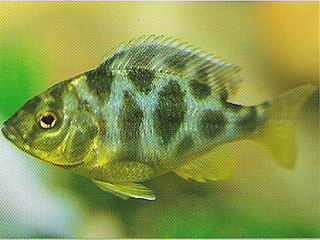Cichlid - Haplochromis Livingstoni
Haplochromis Livingstoni, Livingstoni Cichlid Scientific Name: Haplochromis livingstoni
Sat, 12th July, 2025 - 6:15 am GMT
Sponsor Ads:

Alternative Name
Haplochromis Livingstoni, Livingstoni Cichlid Scientific Name: Haplochromis livingstoniBasic Info
The Haplochromis Livingstoni Cichlid usually grows to between seven and twelve inches (17 to 30 centimeters) in length, though most are eight inches long. Livingstoni Cichlids are mottled in color. This coloration probably aids them in camouflaging themselves in the rocky areas they frequent. Most have a brown and tan or white blotched pattern. The shades are arranged in such a manner that the Livingstoni Cichlid appears to have skin coloring similar to that of military fatigues.
Health
Normally, Livingstoni Cichlids do well in temperatures between 78 and 81 degrees Fahrenheit (27 degrees Celsius). The pH level should remain around 8.0. Enclosures where Haplochromis Livingstoni Cichlids are kept should provide the fish with plenty of hiding places. Often purchased decorations, rocks, or plastic plants are good to use. Rocks are often heavily frequented. Livingstoni Cichlids should be kept alone or with other fish of similar size and temperament. The Haplochromis Livingstoni Cichlid is often fed an omnivorous diet, though the majority of food offered should be items appropriate for a piscivore. A good mix of zucchini, peas, and spinach should supplement the protein portion of its diet - frozen or live plankton, daphnia, beef heart, bloodworms, glass worms, and feeder fish. Although a more natural diet is preferred, many Livingstoni Cichlids do well on freeze dried or tablet food. Breeding Normally, male Haplochromis Livingstoni Cichlids have brighter coloring than females and have more spots on their anal fins. Female Haplochromis Livingstoni Cichlids can produce up to 100 eggs, which are brooded in their mouths.Habitat
Fresh water fish - Livingstoni Cichlid is often found in rocky bottomed areas, where it has a rather unique way of hunting.Behavior
The Haplochromis Livingstoni Cichlid, also known as the "Livingstoni Cichlid", is a popular and beautiful African Cichlid. These lovely fish make interesting display fish or pets. In the wild, the Livingstoni Cichlid is often found in rocky bottomed areas, where it has a rather unique way of hunting. It plays dead to attract small fish by lying on its side among the rocks. When the prey comes close to feed on what it perceives to be a dead fish, the Livingstoni Cichlid quickly springs into motion and eats the would-be scavenger. In captivity, Haplochromis Livingstoni Cichlids normally remain toward the bottom levels of their enclosures. Because they are territorial and often prey on smaller fish, it is advisable not to keep small fish in their aquariums. Usually, they are best kept with other African cichlids that are of similar size and temperament, or by themselves. They will often destroy live plants, so these are not recommended for enclosures where Livingstoni Cichlids are kept.Origin
AfricaHistory
The Haplochromis Livingstoni Cichlid is native to Africa, and is found specifically in Lake Malawi. As its name would suggest, this fish was first officially noted by Livingston.Common Foods
Feed on what it perceives to be a dead fishSponsor Ads:
"the Web is the sum of all human knowledge plus porn." -- Ron Gilbert
Cichlid - Haplochromis Livingstoni
Coded by: BGID® | ALL RIGHTS RESERVED Copyright © 2000-2025
Disclaimer | Privacy | Report Errors / Contact | Credits








 Preparing For China. China is growing their military. China Military Technology - can it keep up with the US?
Preparing For China. China is growing their military. China Military Technology - can it keep up with the US?  versus
versus 

 versus
versus 
 This Thread is about the North Korean Military itself - the kind of army, navy, and air force they have.
This Thread is about the North Korean Military itself - the kind of army, navy, and air force they have. 
 versus
versus 
 versus
versus  versus
versus